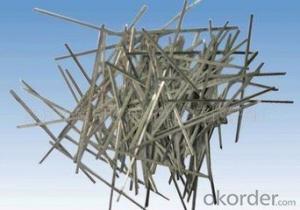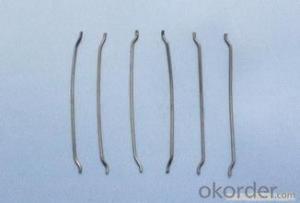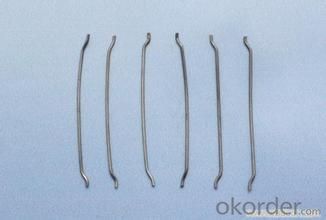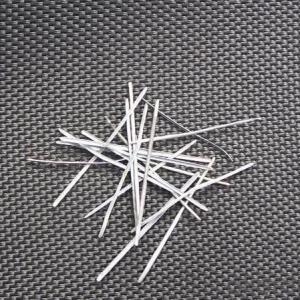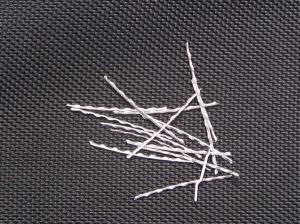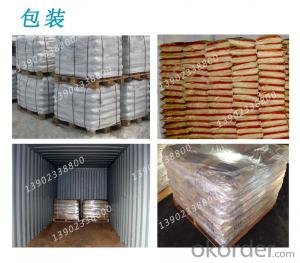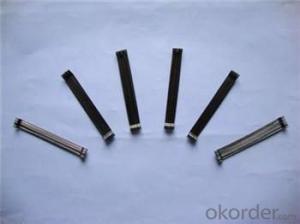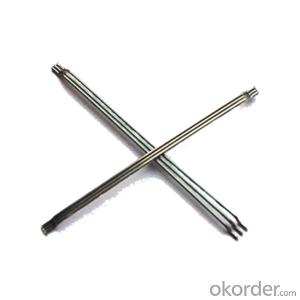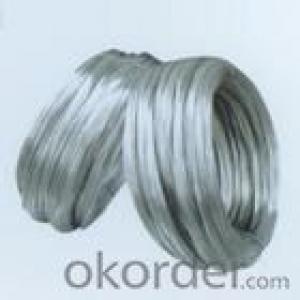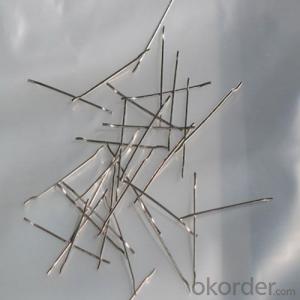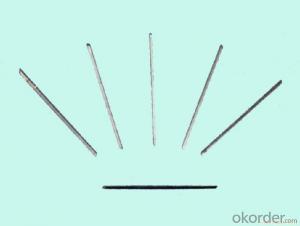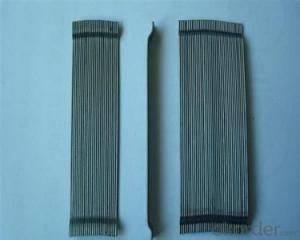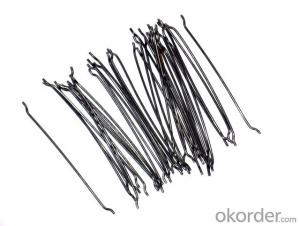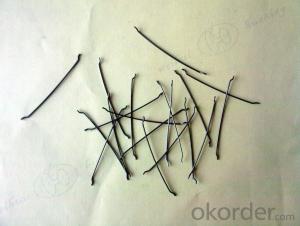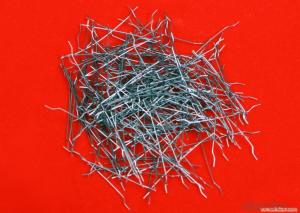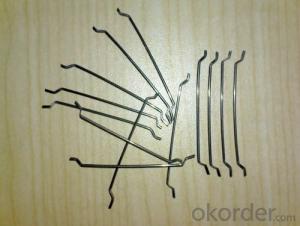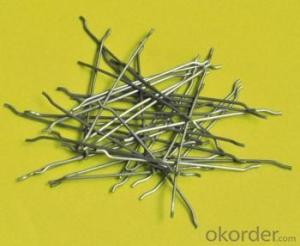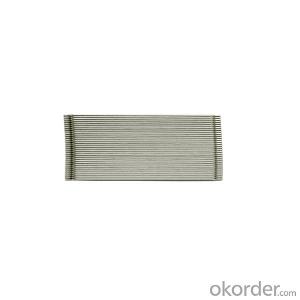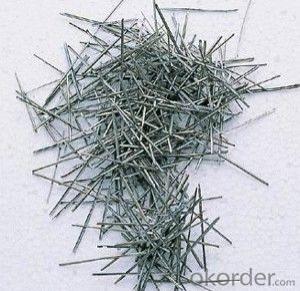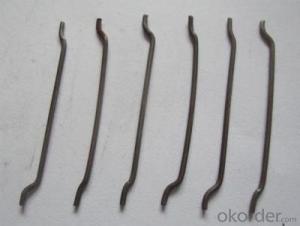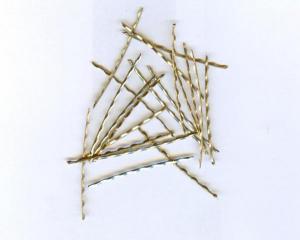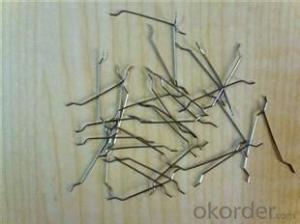Melt Extract Stainless Steel Fiber Loose from CNBM China
- Loading Port:
- Tianjin
- Payment Terms:
- TT OR LC
- Min Order Qty:
- 2000 kg
- Supply Capability:
- 30000 kg/month
OKorder Service Pledge
OKorder Financial Service
You Might Also Like
Quick Details
Place of Origin: Jiangsu, China (Mainland)
Model Number: HT-MC
Material: Color Steel
certificated: ISO 9001
Specifications
ISO 9001 certificated
2.70% for Europe, Middle Asia, America market
3.Have the most number of steel fiber machine in china
1. Material: low carbon steel wire or stainless steel
2.Diameter: 0.4mm-1.0mm
3.Length: meet your requirements
4.tensile strength >1000Mpa
6.Feature: excellent tensile,high tenacity,against cracking,impact and fatigue
7.Uses: highway road surface,tunnel,building,airport road surface and so on .
Straight Steel Fiber
1.ISO 9001 certificated
2.70% for Europe, Middle Asia, America market
3.Have the most number of steel fiber machine in china
Picture
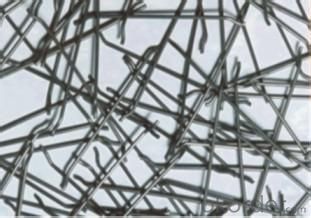
Steel fiber
FAQ
certificated: ISO 9001
Technical advantages of Daye steel fiber:
A. Improve mechanical performance of concrete
B. Provide uniform distribution throughout concrete with excellent mixing
C. No balling or caking by adopt correct mixing method
D. Reduce concrete volume
E.Save construction time and cost
F.Reduce excavation volume
G.Available for jointless floor.
- Q: How does melt extract stainless steel fiber affect the crack propagation in concrete?
- Crack propagation in concrete is significantly impacted by the presence of melt extract stainless steel fiber. When incorporated into the concrete mix, these fibers serve as reinforcement and enhance the material's mechanical properties. The inclusion of stainless steel fibers in concrete effectively regulates the formation and spread of cracks. These fibers are uniformly dispersed throughout the concrete matrix, creating a three-dimensional network that hinders crack growth. The primary mechanism by which stainless steel fibers affect crack propagation is through crack bridging during the drying and hardening process of concrete. As the concrete undergoes tensile stress and begins to crack, the fibers act as small reinforcements that span across the crack faces. This action effectively transfers the applied load and prevents further crack propagation. This bridging effect enhances the concrete's tensile strength and resistance to cracking. Additionally, stainless steel fibers possess high tensile strength and ductility, offering further advantages in controlling crack propagation. Unlike conventional reinforcement methods like steel rebars, stainless steel fibers can withstand significant deformation without fracturing. This characteristic allows the fibers to absorb and distribute energy over a larger area, reducing stress concentration around the cracks and minimizing their growth. Furthermore, the corrosion-resistant nature of stainless steel fibers ensures long-term durability and performance. Unlike other steel fibers, stainless steel fibers do not corrode in the alkaline environment of concrete, thus maintaining their effectiveness over time. In conclusion, the incorporation of melt extract stainless steel fiber into concrete significantly influences crack propagation by bridging cracks, enhancing tensile strength, absorbing energy, and providing long-term durability. These fibers act as reinforcement, improving the overall performance and lifespan of concrete structures.
- Q: Can melt extract stainless steel fiber be used in precast concrete products?
- Yes, melt extract stainless steel fiber can be used in precast concrete products. Melt extract stainless steel fiber is a type of reinforcement material that is added to concrete mixes to enhance their strength and durability. It helps to improve the tensile strength and crack resistance of the concrete, making it suitable for a wide range of applications, including precast concrete products. The stainless steel fibers are typically mixed into the concrete during the batching process and are evenly distributed throughout the mixture. This reinforcement can be particularly beneficial in precast concrete products that may be subjected to high loads or harsh environmental conditions. The addition of melt extract stainless steel fiber can help to prevent cracking and increase the overall lifespan of the precast concrete product.
- Q: How does melt extract stainless steel fiber improve the resistance of concrete to impact loads?
- Melt extract stainless steel fiber improves the resistance of concrete to impact loads by enhancing its toughness and ductility. The fibers act as reinforcement within the concrete matrix, effectively redistributing and absorbing the impact energy. This reduces the likelihood of cracking and spalling, increasing the concrete's ability to withstand impact loads without significant damage.
- Q: How does melt extract stainless steel fiber affect the shrinkage and creep of concrete?
- Concrete's overall strength and durability can be enhanced by incorporating melt extract stainless steel fiber as a reinforcement material. The inclusion of these fibers increases the tensile strength and mitigates the occurrence of cracks. In relation to shrinkage, melt extract stainless steel fibers can effectively decrease the shrinkage of concrete. During the curing process, water evaporation causes the concrete to shrink in volume. The incorporation of stainless steel fibers helps disperse internal stresses and restrict shrinkage. This leads to fewer shrinkage cracks and a reduction in overall shrinkage. Similarly, melt extract stainless steel fibers play a crucial role in managing creep, which is the gradual deformation of concrete over time under sustained loads. Creep is caused by ongoing chemical and physical processes within the concrete. The presence of stainless steel fibers in the concrete provides additional resistance against applied loads, effectively controlling creep deformation. The fibers act as reinforcement, distributing stresses and reducing the overall creep strain in the concrete. In conclusion, the addition of melt extract stainless steel fiber significantly influences the shrinkage and creep characteristics of concrete. It minimizes shrinkage by dispersing internal stresses and restricting volume reduction. Moreover, it manages creep deformation by offering additional resistance against sustained loads and diminishing overall creep strain. Ultimately, the incorporation of stainless steel fibers enhances the long-term performance and durability of concrete structures.
- Q: Can melt extract stainless steel fiber be used in high-strength shotcrete applications?
- Yes, melt extract stainless steel fiber can be used in high-strength shotcrete applications. This type of fiber provides enhanced strength and durability to the shotcrete, making it suitable for demanding applications that require high-strength materials.
- Q: Does melt extract stainless steel fiber improve the ductility of concrete?
- Yes, melt extract stainless steel fiber does improve the ductility of concrete.
- Q: Difference between cement manhole cover and steel fiber manhole cover
- The material is different
- Q: What are the advantages of using melt extract stainless steel fiber?
- The advantages of using melt extract stainless steel fiber include increased strength and durability, improved resistance to corrosion and high temperatures, enhanced crack resistance and impact resistance, and the ability to reinforce and stabilize concrete and other materials. Additionally, stainless steel fiber offers excellent electrical conductivity and electromagnetic shielding properties, making it suitable for various industrial applications.
- Q: Can melt extract stainless steel fiber be used in architectural facades or cladding systems?
- Yes, melt extract stainless steel fiber can be used in architectural facades or cladding systems. It offers excellent strength and durability, making it suitable for enhancing the structural integrity and aesthetics of buildings. Additionally, its resistance to corrosion and weathering makes it an ideal choice for long-lasting architectural applications.
- Q: Does melt extract stainless steel fiber affect the electrical conductivity of concrete?
- Yes, melt extract stainless steel fiber can affect the electrical conductivity of concrete. Stainless steel fibers, when added to concrete, can improve its electrical conductivity. The presence of stainless steel fibers creates a conductive network within the concrete matrix, allowing for the flow of electrical current. This enhanced electrical conductivity can be beneficial in applications where electrical grounding or conductivity is required, such as in the construction of electrostatic discharge (ESD) flooring or in the production of conductive concrete for electromagnetic shielding purposes. However, it is important to note that the actual impact on electrical conductivity will depend on various factors, including the dosage and distribution of the stainless steel fibers within the concrete mixture.
Send your message to us
Melt Extract Stainless Steel Fiber Loose from CNBM China
- Loading Port:
- Tianjin
- Payment Terms:
- TT OR LC
- Min Order Qty:
- 2000 kg
- Supply Capability:
- 30000 kg/month
OKorder Service Pledge
OKorder Financial Service
Similar products
Hot products
Hot Searches
Related keywords
